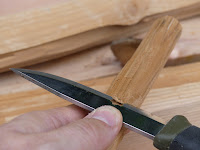Having recently returned form a holiday in Sorrento celebrating my wife and my 50th birthday I started separating the almost inevitable flora and fauna pictures that I'd taken during my time there. Also having worked my way through
Paul Kirtley’s online tree and plant ID course last year I’ve grown my plant knowledge massively (which helped recently in Italy) but
one area that occurred to me that I’ve never got on top of is grass
identification.
Now when I say grass I mean grass and not grarse by the way and whilst I do know Marram grass, the sentinel
of sand dunes, I don’t really know any others. I did however decide to start taking
images of them whilst doing the said course and several things did occur.
|
There is an old adage to help separate the
identification of rushes, grasses and sedges, it’s Rushes are round, sedges
have edges and grasses have ‘knees’.
|
I was getting out and about
during a paid work sabbatical at the same time as the course and found myself visiting many different
locations and habitats and grass was in all of them, from salty lagoons to
montane habitat, in nature reserves to field margins and indeed volcanic in Italy. And it wasn’t only
the variety of habitats that was noticeable because within those areas the
variety of the grass was interesting too.
It could be as thin as a pine
needle and only a few inches high, right through to robust stems which grew the
grass as high as an adult. Some had corn- like seed heads alluding to the
origin of our modern day staples, some had seeds arranged much like a tree’s
foliage and yet there were others that had a cigar shaped arrangement looking
similar in shape to a Cat-tail. And finally the colour range was from deep
green to a pastel purple colour.
Now my grass investigations
didn’t get any deeper than this, however one interesting event occur whilst I
was in the middle of a forage with Carol
Hunt in the earlier in the year and we spotted some grass that seemed to be
shimmering. Upon closer inspection it was covered in small winged insects that
were moving all over the heads. A little bit of investigation later and it turns out that they
were male Common Furrow-Bees and that they were jostling
for top spot in the mass to attract a female.
I also saw Will Lord for a flint knapping and atlatl day and whilst testing the projectile we found some good examples of grass infected with the ergot fungus. We also chanced upon a Grass Snake attempting to consume a Shrew but that's another story.
I also saw Will Lord for a flint knapping and atlatl day and whilst testing the projectile we found some good examples of grass infected with the ergot fungus. We also chanced upon a Grass Snake attempting to consume a Shrew but that's another story.
And grass of course does have its uses within a bushcraft context and the two uses that come foremost to my mind are the fact that it makes a brilliant and readily available tinder bundle (I was told by a wise old sage that flat bladed grass is the best for rolling which seems to be the case), and can be fashioned into supremely strong cordage-come-rope too.
|
I also noticed during the early
stages of a holiday to the Swiss Alps, again last year, that weed filled grassy fields were being copiously watered and
seemed to have no value to the casual observer. It was only further
investigation that revealed that the grass was almost revered as a valuable
crop for the goats, cattle and sheep that were brought down from the higher
elevations during a mass transhumance in the cooler months.
On the face of it this has a
tenuous bushcraft link but this traditional way of life also saw the fields
full of wild flowers too. The other noticeable fact, whether by intent or luck, was that none of the
wild flowers I saw were poisonous varieties and those that I saw ranged from
Hogweed to Self Heal, Nettles to Common Mallow and it’s worth noting that
Riccola, who produce plant based remedies have their growing area in the Alps were I saw grass growing at over 4,000 metres which is impressive.
Swiss hay barn
The cut grass and associated flora is then transferred to raised hay barns for safe storage, it's worth thinking of all this careful and traditional work when you next consume Swiss chocolate. So having had a
Winnie-the-Pooh type ponder over whether will I start trying to identify grass at any stage
in the near future? I think I’ll probably pass (that’s pass and not parse).





































